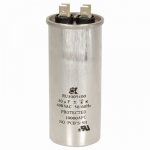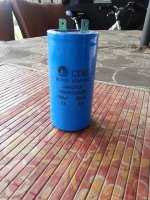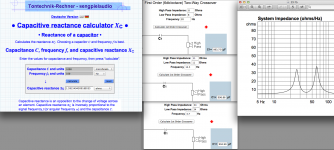Motor start capacitors are typically electrolytic. I have a small stock of them in 20 and 30uF capacities and use them periodically usually at lower/middle frequencies.
I like them because I can keep them on hand and they have been fairly consistent after being thrown into various crossovers with little regard for how hard they'll be worked.
I've also had them connected to tweeters. They don't do much to the sound, the difference from an audio purpose polypropylene is small (YMMV).
I like them because I can keep them on hand and they have been fairly consistent after being thrown into various crossovers with little regard for how hard they'll be worked.
I've also had them connected to tweeters. They don't do much to the sound, the difference from an audio purpose polypropylene is small (YMMV).
Attachments
the last time i saw a motor start cap used as a high pass was in Martin Audio single 15 bass bins to protect the driver surrounds from tearing ask me how i learned why they where in there(it's a woeful tale of reconing several drivers)
it will work but active filters would be better what's your application?
it will work but active filters would be better what's your application?
Thanks, Turk! That's exactly what I'm looking to do, prevent excessive driver excursion. Also perhaps save some wasted amp power.
My current rig is 4-way active with four stereo amps, 700, 400, 200 and 150 watts RMS. The subs are two 12" isobaric, each with two 12" drivers bolted together face to face, one of each driver pairs wired out of phase.
I'm going to convert "Frankenstereo" to 3-way active with passive mid/hi. The subs will be replaced with a single 18" bass reflex or scoop (haven't decided yet). The 12's worked fine, but a little tame for my liking. I need a heart re-starter for when my heart attack arrives LOL. You know, crazy near-field!!!
Thanks, Al.
My current rig is 4-way active with four stereo amps, 700, 400, 200 and 150 watts RMS. The subs are two 12" isobaric, each with two 12" drivers bolted together face to face, one of each driver pairs wired out of phase.
I'm going to convert "Frankenstereo" to 3-way active with passive mid/hi. The subs will be replaced with a single 18" bass reflex or scoop (haven't decided yet). The 12's worked fine, but a little tame for my liking. I need a heart re-starter for when my heart attack arrives LOL. You know, crazy near-field!!!
Thanks, Al.
Al,Thanks, Turk! That's exactly what I'm looking to do, prevent excessive driver excursion. Also perhaps save some wasted amp power.
Problem is you may not prevent excessive driver excursion or save any amp power, and may burn up your amp due to reactance.
I have some very robust PA amplifiers that can withstand near dead shorts, which appeared to be what they were driving when I tried some really large value capacitors as "protection" for some mid drivers.
Some amplifiers would react to the reactance with a puff of smoke from the output transistors.
Anyway, a ported cabinet does not have an even impedance curve, below you can see what the impedance of a nominal 8 ohm driver in a 39 Hz Fb (box tuning) looks like, and what the 1000 uF capacitor does at the various frequencies- around 27Hz, where impedance (and excursion) goes way up, the HP drops to a useless 4.5 Hz.
Get a mini DSP and you can put in the proper filters and align all your future projects without an endless array of caps and coils.
Use the 1000 uF for storing the heart starter paddle juice
Art
Attachments
Hi Art. Thanks for the great info and warning! Before your post, I decided a 20Hz cut would be rather useless with a 6db filter so I figured a cut one octave higher at 40Hz (500uF) made more sense. I assume this new value would pertain to your warning as well? I'm aware of the impedance spike at the drivers Fs. If my cut was above this spike would it solve any problems? I'm not taking into account the box Fb because I haven't chosen a box yet.
Sadly, it looks like I won't be adding any passive filter at the box because I'm taking your advice. The little bit I would gain is not worth the risk of burning up an amp!
BTW, what is a mini DSP? And I absolutely love the paddle quip!!!
Thanks, Al.
Sadly, it looks like I won't be adding any passive filter at the box because I'm taking your advice. The little bit I would gain is not worth the risk of burning up an amp!
BTW, what is a mini DSP? And I absolutely love the paddle quip!!!
Thanks, Al.
Hi,
Series capacitors on speakers work nothing like simple 8
ohm 1st order x/o's, the simple answer is very much no.
Such things (20Hz) are much easier at line level.
The free demo version of Basta! is very good for
showing what really happens with series caps.
rgds, sreten.
Series capacitors on speakers work nothing like simple 8
ohm 1st order x/o's, the simple answer is very much no.
Such things (20Hz) are much easier at line level.
The free demo version of Basta! is very good for
showing what really happens with series caps.
rgds, sreten.
Hi Art. Thanks for the great info and warning! Before your post, I decided a 20Hz cut would be rather useless with a 6db filter so I figured a cut one octave higher at 40Hz (500uF) made more sense. I assume this new value would pertain to your warning as well? I'm aware of the impedance spike at the drivers Fs. If my cut was above this spike would it solve any problems? I'm not taking into account the box Fb because I haven't chosen a box yet.
Sadly, it looks like I won't be adding any passive filter at the box because I'm taking your advice. The little bit I would gain is not worth the risk of burning up an amp!
BTW, what is a mini DSP? And I absolutely love the paddle quip!!!
Thanks, Al.
Dont get mini DSP, dont contaminated the sound with digital artifacts. It is already contaminated enough =). If you want 20Hz cut off, without distorting your sound, what you can do is you can easily adjust your speaker box size and type. Fine tune it so speaker doesnt do much job below 20Hz.
P>S first time I see someone who wants to cut it off from the bottom. Normally people struggle to get proper woofer`s respond below 20 Hz, they create these bizarre boxes, bizarre theories and stuff like that. Then they collect themselves together, listen to bizarre music and chat a little bit about how deep music was, and how it blow their minds...What a world
I might be wrong, but this is how I see the problem. Thanks
Last edited:
Hey Devil! Kind of like a band pass box, right?
And looks like DSP stands for digital sound processor?
Thanks, Al.
Not a band pass box. Say, basic vented box. When you build vented box the first thing you do is buy a woofer. Then you choice a box respond. More flat respond, or more sharp. 0.707 is optimal box responds ( all is example), that guaranties you good sound, no resonance or drops. Then you calculate it. Than you build it. Then you measure your vented port, what a frequency cut-off is in reality. Then you can adjust port or box to get sound that you need. That is quite simple.
Just an example, when you do vented box, your goal is to get as flat response as possible and fine tune the port size so woofer only does positive job, actually creates sound, not distort it or create negative phase shift wave.
This is why I am puzzled about 20 Hz cut off. Why? You can calculate your box (if this is a box) and choose ( specify ) so you need - (some dB) respond below say 50 Hz. It is actually about your box. Woofer itself is just little spoke in the wheel. Your box is what makes sound. And how well you design box, that much you enjoy it at the end =)
yes, DSP is digital signal processing. That is huge topic. I got few books, started to learn and got stuck. Mathematics is very complex. Unless you buy a ready-to-use device or graduate from Uni with DSP degree, I would not recommend to learn it. Time consuming. You can spend whole life and went nowhere at the end. You know. Nowadays science is very rapid grow sport =)
Last edited:
As a newcomer this is very strange, a forum where learning is discouraged.
Gee, I am not doing that, I am just trying to share my experience. Everybody has its own head and has to do what common sense tells him.
Did not want to discourage no one =) Holly truth
Last edited:
So what would you use to prevent overexcursion (which he is wanting to do)?
Well again, all is example. My experience:
I was worried about this as well. What I did, I found good Amplifier with damping factor 1000. Which is what? Which is electrical control over woofers movement. (to prevent over excursion). Some people design Amps with Damping factor 1 or 10, and then till the death speculate how come that Bass is not properly articulated and not deep enough???
Then I designed vented box, the way I explained before.
I am not telling you that my is the only right way, what I am telling you is just how I would do it.
There are plenty of people who would say that I am out-of-date, or old-fashion, that DSP can handle this and that. Few bucks and you can build amazing sound system with DSP control over it. Up to you =) Go for it.
There are plenty of us around here that do the old school quite well. With that said many of us also incorporate various hardware DSP products like the miniDSP line of products or software solutions like Ultimate Equalizer to name a couple.
The anti digital mentality today is so passe it's not funny! Ruled mainly by those whom either refuse to change (stick in the mud) or simply cannot grasp the technology, like most old school mechanics couldn't make the transition to modern automotive computer system diagnostic troubleshooting.
Unless you only listen to records or analog tapes, everything else IS digital.
Even the lowly miniDSP 2x4 can work wonders and is quite high quality.
The anti digital mentality today is so passe it's not funny! Ruled mainly by those whom either refuse to change (stick in the mud) or simply cannot grasp the technology, like most old school mechanics couldn't make the transition to modern automotive computer system diagnostic troubleshooting.
Unless you only listen to records or analog tapes, everything else IS digital.
Even the lowly miniDSP 2x4 can work wonders and is quite high quality.
Hi,
FWIW if you know what you are doing you can use single
rail ampllifiers with a far lower than typical output caps.
Matched to the speakers of course.
e.g. http://www.humblehomemadehifi.com/download/Humble Homemade Hifi_Black Box_copy.pdf
rgds, sreten.
FWIW if you know what you are doing you can use single
rail ampllifiers with a far lower than typical output caps.
Matched to the speakers of course.
e.g. http://www.humblehomemadehifi.com/download/Humble Homemade Hifi_Black Box_copy.pdf
rgds, sreten.
Last edited:
- Status
- This old topic is closed. If you want to reopen this topic, contact a moderator using the "Report Post" button.
- Home
- Loudspeakers
- Multi-Way
- Motor Starting Capacitor
 Moved.. It was a toss up between here and subwoofers, but I assumed it was for a conventional speaker system.
Moved.. It was a toss up between here and subwoofers, but I assumed it was for a conventional speaker system.

